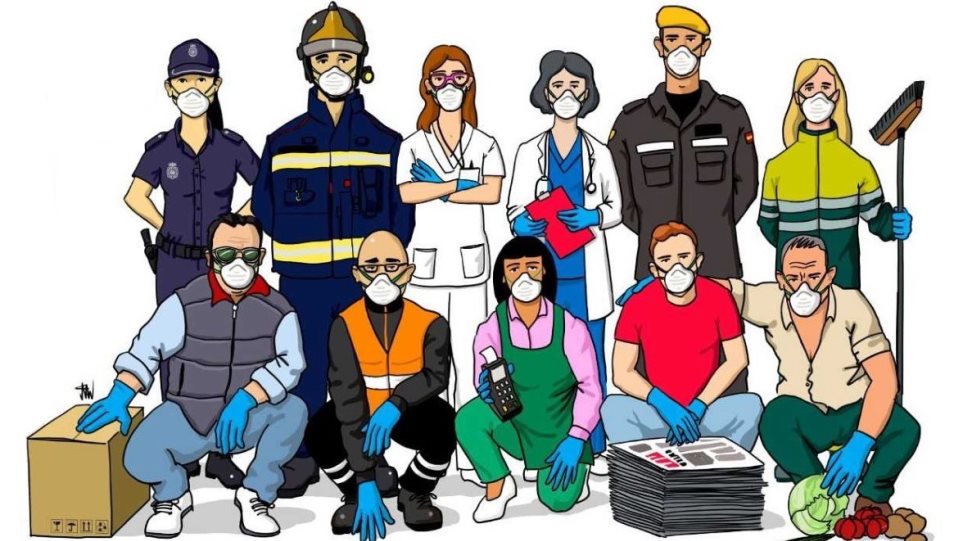Leave a Comment
Posted on March 23, 2020
COVID-19 is “a mild to severe respiratory illness that is caused by a coronavirus,” one that is characterized especially by fever, cough, and shortness of breath and may progress to pneumonia and respiratory failure. The name is an odd sort of acronym, insofar as it is formed from portions of two distinct words (COronaVIrus & Disease) and the latter portion of a date (the 19 from 2019). COVID-19 was first identified in Wuhan, China in December 2019.
Social distance has been in use since the early 19th century, initially with the meaning of “the degree of acceptance or rejection of social interaction between individuals and especially those belonging to different social groups (such as those based on race, ethnicity, class, or gender).” In modern use the term is more often encountered with the meaning of “the avoidance of close contact with other people during the outbreak of a contagious disease in order to minimize exposure and reduce the transmission of infection.” The practice of maintaining a greater than usual physical distance from other people is referred to as social distancing, in use since 2003; the verb is socially distance.
Fomite (which rhymes with ‘toe blight’) is “an object (such as a dish or a doorknob) that may be contaminated with infectious organisms and serve in their transmission.” While this word is infrequently encountered, there has been considerable talk of late about possible surfaces and objects which might harbor infectious substances, and it may well be useful to have this specific word at hand.
Epidemic & Pandemic & Outbreak
An outbreak is “a sudden rise in the incidence of a disease”; an epidemic is “an outbreak of disease that spreads quickly and affects many individuals at the same time”; a pandemic is “an outbreak of a disease that occurs over a wide geographic area and affects an exceptionally high proportion of the population.” An outbreak may become an epidemic if it spreads enough, as an epidemic may likewise become a pandemic.
Community spread is “the spread of a contagious disease within a community." It also has the specific meaning of “the spread of a contagious disease to individuals in a particular geographic location who have no known contact with other infected individuals or who have not recently traveled to an area where the disease has any documented cases.”
Contact tracing is “the practice of identifying and monitoring individuals who may have had contact with an infectious person as a means of controlling the spread of a communicable disease.”
Martial law is “the law administered by military forces that is invoked by a government in an emergency when the civilian law enforcement agencies are unable to maintain public order and safety.” We occasionally see the term misspelled as marshal law, probably due to the fact that marshal has a number of meanings dealing with the military (“a general officer of the highest military rank”) and the enforcement of laws (“an officer having charge of prisoners”). The martial portion of martial law comes from the Latin word martalis, meaning “of Mars” (referring to the Roman god of war).
To self-quarantine is “to refrain from any contact with other individuals for a period of time (such as two weeks) during the outbreak of a contagious disease usually by remaining in one's home and limiting contact with family members.” The verb is fairly recent, showing evidence of use only within the past 20 years or so. The noun has been in occasional use prior to this in the 20th century.
Quarantine is currently most often found with the meaning of “a restraint upon the activities or communication of persons or the transport of goods designed to prevent the spread of disease or pests.” The word has a number of other meanings, both archaic and current, many of which have to do with a period of 40 days (it may be traced back to the Latin word quadraginta, meaning “forty”), including a 40 day period during which a widow was permitted by law to remain in her deceased husband's principal home without having to pay rent to his heirs, a period of 40 days set aside for penance or fasting (in early Christian church use), or a general period of 40 days set aside for a variety of uses.
An index case is “the first documented case of an infectious disease or genetically transmitted condition or mutation in a population, region, or family.” It may also, however, refer to an individual whose has a disease, condition, or mutation that is the first one identified in a population. This second sense is synonymous with index patient. A related term is patient zero, “a person identified as the first to become infected with an illness or disease in an outbreak.” Patient zero is especially used to refer to a person documented as being the first known case of a communicable disease in a particular population or region.
A super-spreader (also written as superspreader) is “an individual who is highly contagious and capable of transmitting a communicable disease to an unusually large number of uninfected individuals.” The term for the spread of disease by super-spreaders is super-spreading.



